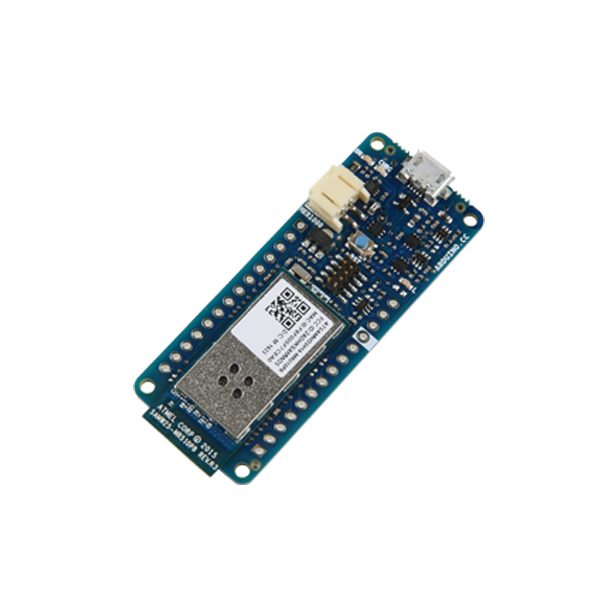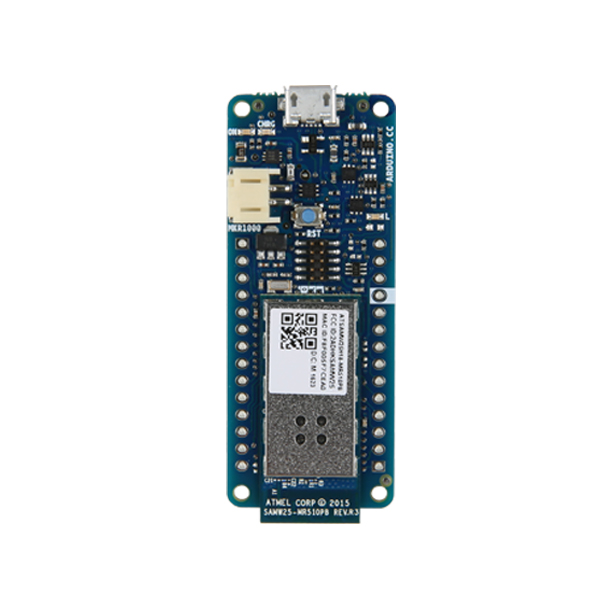Arduino MKR1000
The Arduino MKR1000 is a powerful board that combines the functionality of an Arduino Zero and a handy WiFi shield. This thin board has been designed to offer a practical and cost-effective solution for makers wanting to design IoT projects with minimal previous experience in networking. It is based on the Atmel® ATSAMW25 SoC (System on Chip), that is part of the SmartConnect family of Atmel wireless devices specifically designed for Internet of Things (IoT).
The MKR1000 design includes a LiPo charging circuit that allows the Arduino to run on battery power or external 5V, charging the LiPo battery while running on external power. Switching from one source to the other is done automatically. A good 32-bit computational power similar to the Arduino Zero board, the usual rich set of I/O interfaces, low-power WiFi with a Cryptochip for secure communication, and the ease of use of the Arduino Integrated Development Environment (IDE) for code development and programming. All of these features make this board the preferred choice for the emerging IoT battery-powered projects in a compact form factor. The USB port can be used to supply power (5V) to the board. The Arduino MKR1000 is able to run with or without the LiPo battery connected and has limited power consumption.
Note: This version of the Arduino MKR1000 includes a set of male headers that you can choose to solder on yourself, but if you would like to use a different style of header or would simply not like to have headers on your MKR1000, that is also fine! If you would like an Arduino MKR1000 with headers already mounted to the board, purchase this version instead.
- 1x Arduino MKR1000 Board
- 2x Male 0.1" Headers
- Microcontroller: SAMD21 Cortex-M0+ 32-bit low-power ARM MCU
- Board Power Supply (USB/VIN): 5V
- Circuit Operating Voltage: 3.3V
- Digital I/O Pins: 8
- PWM Pins: 12
- Flash Memory: 256 KB
- SRAM: 32 KB
- Full-speed USB device and embedded host
Arduino MKR1000 Product Help and Resources
Adding More SERCOM Ports for SAMD Boards
February 4, 2019
How to setup extra SPI, UART, and I2C serial ports on a SAMD-based boards.
Core Skill: Soldering
This skill defines how difficult the soldering is on a particular product. It might be a couple simple solder joints, or require special reflow tools.
Skill Level: Noob - Some basic soldering is required, but it is limited to a just a few pins, basic through-hole soldering, and couple (if any) polarized components. A basic soldering iron is all you should need.
See all skill levels
Core Skill: Programming
If a board needs code or communicates somehow, you're going to need to know how to program or interface with it. The programming skill is all about communication and code.
Skill Level: Rookie - You will need a better fundamental understand of what code is, and how it works. You will be using beginner-level software and development tools like Arduino. You will be dealing directly with code, but numerous examples and libraries are available. Sensors or shields will communicate with serial or TTL.
See all skill levels
Core Skill: Electrical Prototyping
If it requires power, you need to know how much, what all the pins do, and how to hook it up. You may need to reference datasheets, schematics, and know the ins and outs of electronics.
Skill Level: Rookie - You may be required to know a bit more about the component, such as orientation, or how to hook it up, in addition to power requirements. You will need to understand polarized components.
See all skill levels
Comments
Looking for answers to technical questions?
We welcome your comments and suggestions below. However, if you are looking for solutions to technical questions please see our Technical Assistance page.
Customer Reviews
5 out of 5
Based on 1 ratings:
Great prototype to project install board
This is the best board for working with WIFI and micro controllers. I like it for driving complex LED projects. It’s a nice touch that you can power this from a power supply via a pin on the board and are not forced to power via the USB or battery jack like other similar boards.
I’ve had one of these boards rocking every day for 8 hours a day in a restaurant LED installation. No problems yet.




